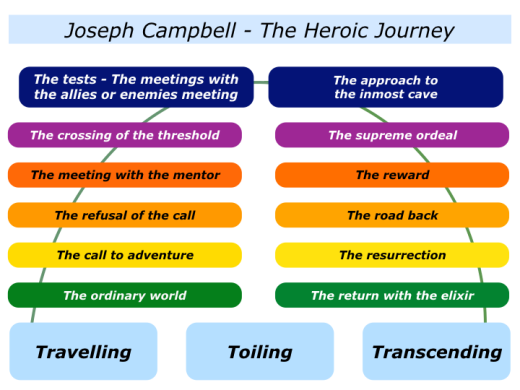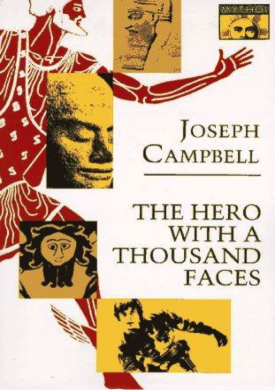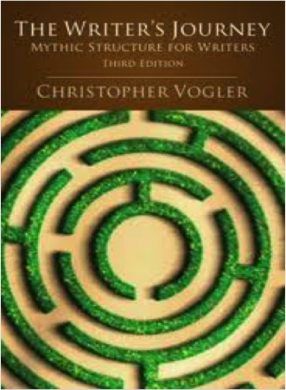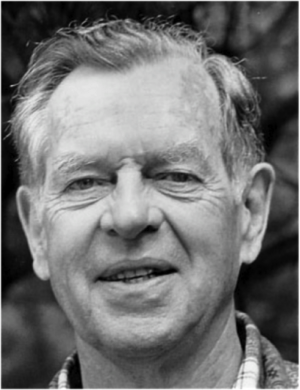People have always wanted to follow their dreams. This often involves pursuing some kind of personal or professional ‘odyssey’.
Sometimes the odyssey involves an outer journey, sometimes an inner journey, sometimes a combination of both. Reaching the goal produces a sense of peace. They rest for a while – then embark on another journey.
Pursuing such journeys often involves building on your strengths and being tested on your weaknesses. There are many psychological models for understanding this journey. But insights can be also gained from the work of Joseph Campbell.
Studying myths and legends from many civilisations, he found they often followed a similar structure. He described this in his book The Hero with a Thousand Faces. You can discover more about his work at the Joseph Campbell Foundation.
Joseph’s writings were popularised by Christopher Vogler in his book The Writer’s Journey. This became a set text for budding writers across the world. George Lucas brought Campbell’s work to an even wider audience, however, when paying homage to it as the director of Star Wars.
The heroic journey involves many stages. But let’s explore three overall steps that people take when pursuing their chosen journey.
Travelling – setting-out on the
journey towards the ‘Grail’
You may be content in your world, but then comes the call to pursue an adventure or tackle a challenge. For example, you may lose your job, get an illness, see an injustice or catch a glimpse of the Holy Grail.
At first you refuse the call but, after repeated asking, you embark on the journey. Now you are in a different world and do not know the rules, so you gather information and search for a compass. Looking for guidance, you will meet helpers: but are they friends or enemies? Nevertheless, you continue on your chosen path.
Toiling – working hard on the
journey towards the ‘Grail’
You encounter tests on the journey: toils, trials and tribulations. There are highs, lows, breakthroughs and setbacks, but you try to keep your eyes on the Grail.
Christopher Vogler’s book shows how film plots often follow the structure that Joseph Campbell found in myths and legends. He writes:
“A hero leaves her comfortable, ordinary surroundings to venture into a challenging, unfamiliar world.
“It may be an outward journey to an actual place: a labyrinth, forest or cave, a strange city or country, a new locale that becomes the arena for her conflict with antagonistic, challenging forces…”
“But there are many stories that take the hero on an inward journey, one of the mind, the heart, the spirit.
“In any good story the hero grows and changes, making a journey from one way of being to the next: from despair to hope, weakness to strength, folly to wisdom, love to hate, and back again.
“It’s these emotional journeys that hook an audience and make a story worth watching.”
(The Heroine’s Journey is similar to The Hero’s Journey, but with one vital difference. Women gather knowledge and wisdom from the tribe earlier. Men only ask for help at the last moment. Even then they may see it as a sign of ‘weakness’.)
You can learn more about Christopher Vogler’s work via the following link.
https://chrisvogler.wordpress.com/
Overcoming challenges, you finally stand on the edge of ‘victory’. You venture into what Campbell calls ‘the inmost cave’ and face the ‘supreme ordeal’.
How will you behave in this moment of truth? For example, will you be generous or will you submit to greed? Will you fight, flee or flow?
Transcending – lifting the ‘Grail’ and
gathering wisdom from the journey
You can only do your best, so you do the right thing. Sometimes you will lift the prize; sometimes you will simply gather wisdom for a future journey. You may enjoy a moment of transcendence – an epiphany – and see the world as if for the first time.
The Hero/Heroine sometimes returns with the prize, but first there is the journey home. This is the return to the ‘ordinary world’.
How can you make sense of what you have learned? Will people be able to understand? That is when the wisdom begins to seep into your bones and you are changed forever.
Joseph Campbell says people take one of three routes after returning to the world.
They share their vision, but the world does not want to know, so they retreat back to the woods, ‘with a dog and a pipe’.
They meet resistance, become disheartened, and revert to the ‘world’s way’.
They make a living by becoming, in the broadest sense, a ‘teacher’ and pass-on their message to people who are receptive.
Days, weeks and months pass. You rest for a while, but then you become restless. There is another mountain to climb, another adventure to pursue.
So you embark on your next chosen journey. Or does the journey choose you?
Matthew Winkler was fascinated by Joseph Campbell’s work on The Heroic Journey. He wanted to share this in a way that would reach many people. So he created the basis for this short film which is posted below. Matthew wrote:
“I was studying the literary foundations of the quest story for a book I’m writing. I decided to synthesize my research into a twelve-stage heroic cycle based on the face of a clock, a device that everyone understands.
“I wrote the lesson script and submitted it to TED-Ed, and they matched me with a gifted animator.”










Leave a Reply